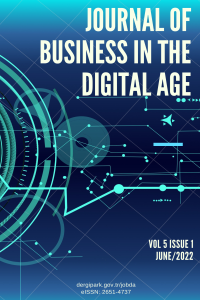PANDEMİ SÜRECINDE HASTANELERDE KİŞİSEL KORUYUCU EKİPMAN (KKE) DAĞITIMININ SÜREÇ YÖNETIMI TEKNİĞİ İLE DEĞERLENDİRİLMESİ
Sağlık çalışanları, klinik ortamda bulaşıcı mikroorganizmalar veya tehlikeli maddelere karşı maruziyetlerini en aza indirmek için kişisel koruyucu ekipman (KKE) kullanırlar. Bulaşıcı enfeksiyonlardan korunmak amaçlı el hijyeni gibi standart önlemlere ek olarak bulaşı fiziksel olarak engellemek için eldiven, önlük ve yüz koruması sağlayan maskeler gibi ekipmanlar da kullanılır. Enfekte hastanın izole edilmesinin yanında KKE’ler sağlık personeli için ilk koruma hattıdır. Covid 19 pandemisinin hızla yayılımına paralel olarak insanların sağlık hizmetlerine olan talebi her geçen gün artmaktadır. Taleplerin karşılanması sırasında tedavileri hastane yatışı gerektiren enfekte hastalardan sağlık çalışanlarına enfeksiyon bulaşmasını önlemek ise KKE’lerin etkili kullanımına bağlıdır. Bu çalışmada amaç, bir üniversite hastanesinde pandemi döneminde KKE’lerin hastane içerisinde dağıtımını incelemek ve süreç iyileştirme teknikleri kullanarak dağıtım sürecini en uygun hale getirmektir. Çalışmamız gözlemsel çalışma olup, sağlık çalışanlarının bulaş riskini en aza indiren KKE dağıtımının hastane kaynaklarının etkin kullanımını da ön planda tutarak nasıl yapılması gerektiği hakkında sağlık yöneticilerine öneriler sunmayı amaçlamaktadır.
Anahtar Kelimeler:
Kişisel Koruyucu Ekipman, Süreç Yönetimi, Malzeme Dağıtım Süreci
EVALUATION OF PERSONAL PRODUCTIVE EQUIPMENT (PPE) DISTRIBUTION IN HOSPITALS WITH PROCESS MANAGEMENT TECHNIQUE DURING THE PANDEMIC PROCESS
Healthcare professionals use personal protective equipment (PPE) to minimize their exposure to infectious microorganisms or hazardous substances in the clinical setting. In addition to standard measures such as hand hygiene to prevent contagious infections, equipment such as gloves, gowns and masks that provide face protection are also used to physically prevent transmission. In addition to isolating the infected patient, PPEs are the first line of protection for healthcare personnel. In parallel with the rapid spread of the Covid 19 pandemic, peoples demand for health services is increasing day by day. Preventing the transmission of infection from infected patients whose treatments require hospitalization to healthcare workers while meeting the demands depends on the effective use of PPEs. The aim of this study is to examine the distribution of PPE in a university hospital during the pandemic period and to optimize the distribution process by using process improvement techniques. Our study is an observational study and offers suggestions to health managers about how PPE distribution, which minimizes the risk of contamination of healthcare workers, should be done by keeping the effective use of hospital resources in the foreground.
___
- Benner, M. J.; Tushman, M. L.: “Exploitation, Exploration, and Process Management: The Productivity Dilemma Revisited”, The Academy of Management Review, Vol 28 No 2 (2003) 238-256. Giuseppe I. F., Aili B. B., Hans-Henrik H., Jan Ola S. Material Distribution and Transportation in a Norwegian Hospital: A Case Study.IFAC PapersOnLine 51-11 (2018) 352–357
- Kaur, H., Singh, S.P., 2019. Sustainable procurement and logistics for disaster resilient supply chain. Ann. Oper. Res. 283 (1), 309–354.
- Laguna, M.; Marklund, J.: Business Process Modeling, Simulation, and Design, Pearson/Prentice Hall, NJ, USA, (2004).
- Michael H. Cecire, COVID-19 and Domestic PPE Production and Distribution: Issues and Policy Options, Congressional Research Service, December 7, 2020
- Michelon P., Cruz M.D., Gascon V. Using the tabu search method for the distribution of supplies in a hospital Annals of Operations Research, 50 (1994), pp. 427-435
- Palmberg, K.: “Exploring process management: Are there any widespread models and definitions?”, The TQM Journal, Vol 21 No 2 (2009) 203-15.
- Sarma, D., Das, A., Bera, U.K., Hezam, I.M., 2019. Redistribution for cost minimization in disaster management under uncertainty with trapezoidal neutrosophic number. Comput. Ind. 109, 226–238.
- Yayın Aralığı: Yılda 2 Sayı
- Başlangıç: 2018
- Yayıncı: Berrin ONARAN
